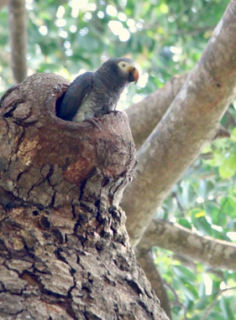Timneh Parrot |
|
|
Also known as: Timneh Grey
Did You Know?
P. timneh was once conspecific with (a subspecies of) P. erithacus.
Programs & Projects
WPT has worked with numerous partners to help save this species. Learn moreAcademic Research
Related publications: Psittacus timnehSpecies Profile
Genus: Psittacus | Species: timneh
Size:
30cm (11.7 in)
Weight:
320g (11.2 oz)
Subspecies including nominate:
one
Colour Adult:
Both adults dark grey in colour, paler on rump and abdomen than Grey Parrot; dark grey lower undertail coverts tinged with dark red; dark burgundy tail, the feathers edged with brown. Upper mandible dark red tipped with black, lower mandible black; smaller in size than Grey Parrot.
Colour Juvenile:
As in adults but with grey tinged lower undertail coverts; tail tipped with red. Eye dark grey to black.
Call:
Variety of whistles, squawks, shrieks, and screams given at rest and in flight; mimics other birds, and mammals.
Listen NowVideo Links:
Video 1More Information:
Content Sources:
CITES
BirdLife International
Cornell Lab of Ornithology/Birds of the World
A Guide to Parrots of the World, Juniper and Parr, 1998
xeno-canto Timneh Parrot, Leroy, Etienne, XC216300
Parrots of the World, Forshaw, 2006. 2010 edition
Parrots in Aviculture, Low, 1992.
Lexicon of Parrots, Thomas Arndt.
Did You Know?
P. timneh was once conspecific with (a subspecies of) P. erithacus.
Programs & Projects
WPT has worked with numerous partners to help save this species. Learn moreAcademic Research
Related publications: Psittacus timnehSpecies Care
Captive Status:
Heavily imported with high mortality. Is taken for markets locally and the middle and far east. From 1994-2003 over 359,000 individuals (erithacus and timneh combined) were traded on the international market.
Longevity:
50-60 yrs
Housing:
Aviary or suspended cage, minimum length 3m (9.8 ft).
Diet:
Cooked beans and pulses, boiled corn, sunflower seed - dry, soaked or sprouted but limited; fruit such as: apple, orange, banana, pomegranate, pear; rearing food (hard boiled egg, wholegrain bread and carrot); vegetables such as: carrot, celery, green beans and peas in the pod; spray millet; complete kibble.
Enrichment:
Provide overhead misters or shallow water bowls for bathing; foot toys, destructible (non-toxic) toys, non-destructible (non-toxic plastic) toys, food-finder toys, preening toys, different texture and size hanging perch toys; fir, pine, elder or willow branches, push-and-pull toys (sliding up and down), vegetable tanned leather toys. Introduce with care, as some Timnehs are sensitive to novel things.
Nest Box Size:
Vertical box 12" x 12" x 24" (30.5cm x 30.5cm x 61cm).
Clutch Size:
2-3
Incubation Time:
28-30 days
Fledging Age:
11-12 weeks
Hatch Weight:
12g (0.5oz)
Peak Weight:
418g (14.6oz)
Weaning Weight:
372g (13oz)
Did You Know?
P. timneh was once conspecific with (a subspecies of) P. erithacus.
Programs & Projects
WPT has worked with numerous partners to help save this species. Learn moreAcademic Research
Related publications: Psittacus timnehSpecies Wild Status
World Population:
100,000-500,000, decreasing.
IUCN Red List Status:
Endangered
CITES Listing:
Appendix I
Threat Summary:
The species has been heavily traded on the international market: 199,070 individuals have been exported from 2005-2014. Habitat loss (up to 77%) is also significantly impacting the species' range. In Guinea and Guinea-Bissau there have been marked losses of the birds' preferred nest trees.
Range:
The western parts of the Upper Guinea forests and bordering savannas of West Africa, from Guinea-Bissau east through Guinea, Sierra Leone and Liberia to east of the Bandama River in Côte d'Ivoire.
Habitat:
Found in primary and secondary rainforest, forest edges and clearings, gallery forest, mangroves, savanna and cultivated land.
Wild Diet:
Diet includes a variety of fruits and seeds, particularly oil palm fruit, also consumes Cola tragacantha, Pseudospondias microcarpa, Ficus, Heisteria, Dacryodes, Petersianthus, Combretum, Macaranga, Raphia, Harungana, Ceiba, Blighia, Bombax, Celtis, Caccia, Petersianthus, Parkia, Terminalia and maize.
Ecology and Behaviour:
Will sometimes travel far distances for food. Nests in tree-cavities far above ground. Found in small flocks of a few dozen, usually not more. Flocks may be noisy.
Clutch and Egg Size:
2-3
Breeding Season:
During dry season, January-February, and June-July. Nest is in high, live tree in hollow.
Related Links:
Did You Know?
P. timneh was once conspecific with (a subspecies of) P. erithacus.
Programs & Projects
WPT has worked with numerous partners to help save this species. Learn moreAcademic Research
Related publications: Psittacus timnehMembers Only Resources
Please log-in now to find more research, resources and tools.
Not a Member?
Find more great information:
Gain exclusive access to 600+ pages of additional research, seminars and podcasts, specialists to ask your toughest questions, and dozens of other fun resources - when you become a WPT member.
Join Today >>

































